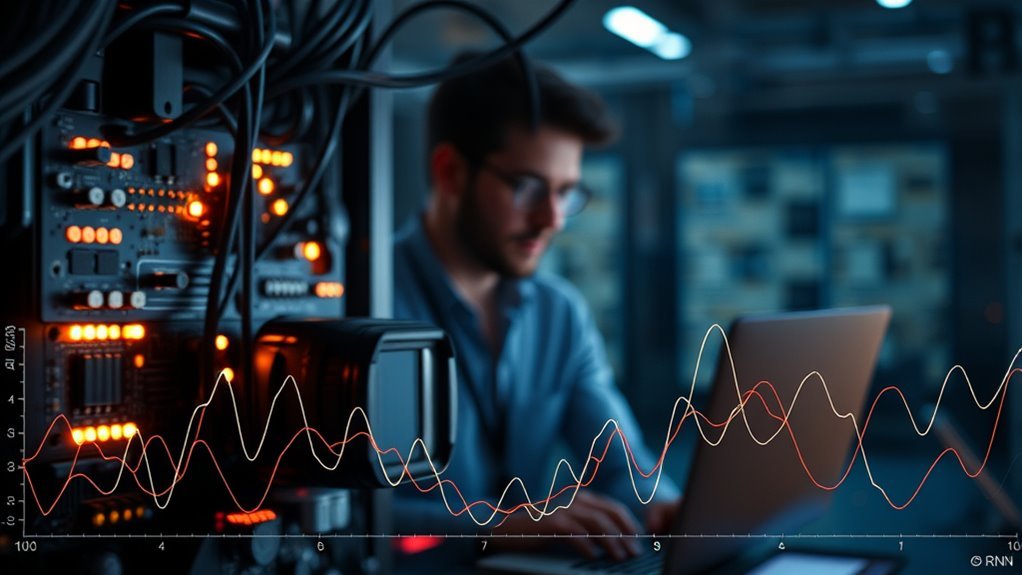When implementing RNNs for time-series data, you’ll want to start by preprocessing with normalization and windowing to capture temporal patterns effectively. Choose suitable recurrent layers like LSTMs or GRUs for handling long dependencies. Design your architecture carefully to avoid overfitting by applying dropout and early stopping. Evaluate with metrics like MAE or RMSE using walk-forward validation to guarantee robustness. Understanding these fundamentals prepares you to explore advanced techniques and real-world use cases for time-series modeling.
Understanding the Basics of Recurrent Neural Networks

Although you might be familiar with traditional neural networks, understanding recurrent neural networks (RNNs) requires recognizing their unique ability to process sequential data by maintaining hidden states that capture temporal dependencies. At the core of RNN fundamentals is the concept that each output depends not only on the current input but also on previous computations, enabling memory across time steps. This structure makes RNNs ideal for tasks involving sequential data, such as time-series prediction or natural language processing. You’ll find that RNNs iterate through sequences, updating hidden states to retain context. By mastering these basics, you gain the freedom to design models that effectively handle data where order and temporal relationships matter, providing a foundation for more advanced sequence modeling techniques.
Key Challenges in Time-Series Prediction

With a solid grasp of how RNNs maintain temporal context, you can now address the complexities involved in time-series prediction. You’ll face challenges such as data sparsity and seasonality effects that complicate temporal dependencies. Effective noise reduction and outlier detection are essential to enhance model interpretability. Multi step forecasting requires careful feature selection and leveraging lagged variables. Data augmentation can mitigate limited sample sizes, improving robustness. Utilizing cloud-based machine learning platforms can significantly streamline experimentation and deployment of RNN models for time-series data.
| Challenge | Description | Strategy |
|---|---|---|
| Data Sparsity | Limited observations | Data augmentation |
| Seasonality Effects | Periodic fluctuations | Feature selection |
| Noise & Outliers | Distort underlying patterns | Noise reduction, detection |
| Multi Step Forecasting | Predicting multiple future steps | Use lagged variables |
Address these to reveal RNNs’ full potential in your time-series tasks.
Preparing Time-Series Data for RNN Input

Before feeding your time-series data into an RNN, you need to transform it into a format that preserves temporal dependencies while aligning with the model’s input requirements. Start by applying data normalization and feature scaling to stabilize variance and accelerate training convergence. Use time windowing to segment sequences into fixed-length input-output pairs, enabling the RNN to learn temporal patterns effectively. Incorporate lag features to capture historical context explicitly. Perform seasonal decomposition and trend analysis to isolate seasonality and long-term trends, improving model interpretability and performance. Implement anomaly detection to identify and handle outliers that could distort learning. Finally, consider data augmentation techniques, such as jittering or time warping, to expand your dataset’s diversity without compromising temporal integrity, ensuring robust and generalizable RNN training.
Designing an RNN Architecture for Sequential Data
When designing your RNN architecture, selecting the appropriate recurrent layers—such as LSTM or GRU—is essential for capturing temporal dependencies. You’ll also need to manage sequence lengths effectively, using techniques like padding or truncation to guarantee consistent input dimensions. These decisions directly impact your model’s ability to learn from sequential data and generalize well.
Choosing Recurrent Layers
Although selecting the right recurrent layer is essential, you’ll need to balance model complexity with the specific characteristics of your time-series data. Begin with layer selection by comparing architectures like Simple RNNs, LSTMs, and GRUs, focusing on their activation functions and suitability for your task. Employ complexity analysis to weigh computational cost against feature extraction capabilities. Layer stacking can enhance temporal representation but demands careful model tuning to prevent overfitting. Adopt systematic training strategies and leverage performance metrics for iterative refinement. Hyperparameter optimization, including adjusting layer depth, units, and learning rates, is critical for maximizing accuracy and efficiency. By integrating architecture comparison with rigorous model tuning, you gain the freedom to customize your RNN to the nuances of your sequential data, ensuring robust and interpretable results.
Handling Sequence Lengths
Since sequence length directly impacts both model performance and computational efficiency, you’ll need to carefully design your RNN architecture to handle varying input sizes. When dealing with variable sequences, padding techniques and truncating sequences guarantee uniformity for batch processing, preventing misalignment during sequence modeling. Dynamic batching further optimizes computation by grouping similar-length sequences together, reducing unnecessary padding overhead. Sequence normalization helps manage scale differences, improving convergence in time series forecasting tasks. Handling irregularities in sequence length requires careful sequence alignment strategies to maintain temporal coherence. By combining these methods, you preserve data integrity and boost model efficiency, allowing your RNN to flexibly adapt to diverse time-dependent inputs without sacrificing speed or accuracy. This approach grants you the freedom to work effectively with real-world, irregular time series data.
Implementing Simple RNNS With Python and Tensorflow
Implementing simple RNNs with Python and TensorFlow involves defining a recurrent layer that processes sequential data step-by-step, capturing temporal dependencies. You start by importing TensorFlow’s Keras API, then instantiate an RNN layer like tf.keras.layers.SimpleRNN. When comparing RNN libraries, TensorFlow strikes a balance between flexibility, community support, and production readiness. After building your model, focus on RNN hyperparameter tuning—adjust the number of units, activation functions, and dropout rates to optimize performance. Use techniques like grid search or manual tuning to find the best configuration. Remember to set input shapes matching your time-series data and compile with appropriate loss functions. This approach grants you the freedom to experiment while maintaining efficient model training and evaluation pipelines.
Exploring Long Short-Term Memory (LSTM) Networks
You’ll find that LSTM networks improve on simple RNNs by incorporating gates to control information flow, which helps in capturing long-term dependencies. Their architecture includes forget, input, and output gates that regulate the cell state effectively. This design makes LSTMs particularly suited for various time-series applications like forecasting and anomaly detection.
LSTM Architecture Overview
Although traditional RNNs struggle with long-term dependencies, LSTM networks overcome this limitation by using a specialized gating mechanism. The core of the LSTM architecture lies in its lstm cell structure, designed to regulate information flow effectively. It consists of a cell state that carries relevant data across time steps, modulated by three primary lstm gate functions: the input gate, forget gate, and output gate. The input gate controls which new information updates the cell state, the forget gate decides what information to discard, and the output gate determines the output based on the cell state. This gating system enables LSTMs to selectively remember or forget information, allowing you to model complex temporal dependencies in time-series data without suffering from vanishing gradients.
Applications in Time-Series
With a solid grasp of the LSTM architecture and its gating mechanisms, you can now explore how these networks excel in handling complex time-series tasks. LSTMs are pivotal in financial forecasting and stock prediction, capturing temporal dependencies to enhance accuracy. They effectively detect anomalies in healthcare monitoring and energy consumption, ensuring timely interventions. Weather modeling and traffic prediction benefit from LSTM’s ability to process sequential data, improving reliability. In demand forecasting and resource allocation, these networks optimize planning by analyzing historical trends. Additionally, LSTMs advance sentiment analysis by interpreting evolving textual data over time. Their capacity to retain long-term information while mitigating vanishing gradients makes them indispensable for diverse time-series applications, granting you the flexibility to model intricate patterns and drive informed decisions across multiple domains.
Using Gated Recurrent Units (GRUs) for Efficient Modeling
Since traditional RNNs often struggle with vanishing gradients, Gated Recurrent Units (GRUs) offer a streamlined alternative that balances performance and computational efficiency. You’ll find the GRU architecture simpler than LSTMs, with fewer gates, enhancing GRU efficiency during training and inference. GRU advantages include faster convergence and reduced computational overhead, making them ideal for real-time time-series applications. However, GRU limitations arise in modeling very long dependencies compared to some LSTM variations. When tuning GRUs, focus on adjusting gate biases and hidden units to optimize performance. In GRU comparison, they often outperform simple RNNs and rival LSTMs on many datasets. GRU applications span speech recognition, financial forecasting, and sensor data analysis. Exploring different GRU variations helps you tailor models for your specific time-series challenges.
Evaluating Model Performance on Time-Series Tasks
When you’re working with time-series models, evaluating their performance requires metrics and techniques tailored to the temporal structure of the data. Effective model evaluation hinges on selecting appropriate performance metrics such as Mean Absolute Error (MAE) or Root Mean Squared Error (RMSE), which capture predictive accuracy while respecting sequence order. Employ time series benchmarks and cross validation techniques like walk-forward validation to guarantee model robustness across temporal splits. Conduct thorough error analysis to identify systematic biases or temporal drift. Use evaluation frameworks that streamline comparison studies, enabling you to assess multiple models under consistent conditions. Thoughtful metric selection and rigorous evaluation frameworks empower you to confidently gauge your RNN’s ability to generalize, assuring reliable deployment in real-world time-series tasks.
Techniques to Prevent Overfitting in RNN Models
To improve your RNN model’s generalization, you need to apply regularization methods like dropout and weight decay. Monitoring validation loss allows you to implement early stopping, halting training before overfitting occurs. These techniques help maintain model performance on unseen time-series data.
Regularization Methods Overview
Although RNNs are powerful for modeling time-series data, they’re prone to overfitting due to their complexity and temporal dependencies. To counter this, you should employ regularization methods that promote generalization. Dropout techniques randomly deactivate neurons during training, preventing co-adaptation and reducing overfitting. Applying dropout to recurrent connections requires care to maintain temporal consistency. Weight decay, or L2 regularization, penalizes large weights by adding a term proportional to the squared magnitude of weights to the loss function. This discourages complex models from fitting noise in the training data. Combining dropout techniques with weight decay strikes a balance between model capacity and robustness. By integrating these regularization strategies, you’ll guarantee your RNN captures meaningful patterns in time-series data without memorizing noise.
Early Stopping Strategies
Since overfitting remains a significant challenge in training RNN models, early stopping offers an effective way to halt training before the model begins to memorize noise. By monitoring performance on a validation set, you can detect when the model’s generalization starts to degrade. Implementing early stopping involves:
- Continuously evaluating loss or accuracy on the validation set during training
- Defining a patience parameter to wait for improvement before stopping
- Saving the best model weights observed on the validation set
- Avoiding excessive training epochs that lead to overfitting
This strategy guarantees you maintain model freedom, preventing unnecessary complexity and preserving generalization. Early stopping is a straightforward yet powerful regularization technique that complements other methods, helping you build robust RNNs for time-series forecasting without overfitting.
Real-World Applications of RNNs in Time-Series Analysis
Time-series data plays a crucial role across many industries, and Recurrent Neural Networks (RNNs) have proven effective in modeling its temporal dependencies. You can leverage RNNs for stock price prediction and financial market analysis, capturing complex sequential patterns. In energy consumption forecasting and weather pattern analysis, RNNs provide precise temporal insights to optimize resource allocation. Healthcare monitoring systems benefit by detecting anomalies over time, improving patient outcomes. Sales forecasting models and traffic flow prediction utilize RNNs to anticipate demand and congestion dynamically. Additionally, IoT data processing harnesses RNNs for real-time sensor data interpretation, while fraud detection systems analyze transaction sequences for irregularities. Sentiment analysis trends also gain from RNNs’ ability to track evolving public opinion. By applying RNNs across these domains, you reveal powerful predictive capabilities, essential for informed decision-making. Leveraging cloud scalability can further enhance the training and deployment efficiency of RNN models for time-series data.



